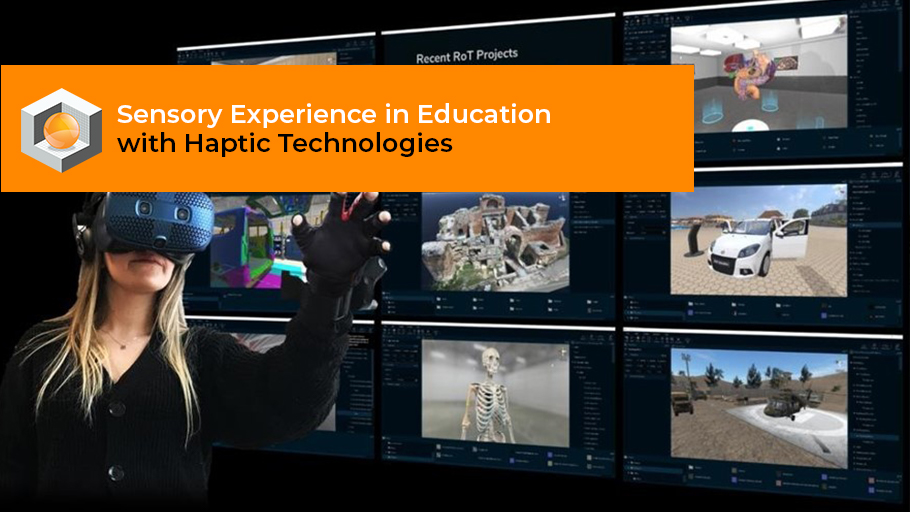Sensory Experience in Education with Haptic Technologies introduces a multisensory educational model that goes beyond traditional learning methods. Unlike classical digital education limited to visual and auditory content, haptic technologies incorporate tactile interaction, making learning processes more realistic, effective, and lasting. Especially when integrated with VR and XR technologies, these systems allow participants to engage with knowledge not just mentally but also physically. Tactile feedback significantly increases learning efficiency, particularly in training requiring technical skills.
Sensory Experience in Education with Haptic Technologies is regarded as the new phase of digitalization in corporate training. The RoT STUDIO License offers organizations advanced tactile feedback-supported training scenarios through its innovative infrastructure. Thanks to its user-friendly interface and no-code structure, haptic features can be easily integrated into training processes. This allows employees not only to observe but to become a physical part of the training, thereby increasing retention rates and developing behavioral reflexes.
What is Haptic Technology and Why is it Important in Education?
Haptic technology is an advanced technology that enables users to interact with digital environments through physical senses such as touch, force, and vibration. These systems offer sensory feedback in virtual environments, allowing users to feel the presence, weight, or resistance of objects, just like in the real world.
Especially in educational processes, internalizing abstract concepts through physical contact significantly enhances learning retention.
The importance of haptic technology in education is not limited to the presence of physical sensation; it also activates the brain’s sensorimotor connections, facilitating the transfer of information to long-term memory.
Learning becomes much more powerful when it occurs not just by seeing or hearing but by experiencing firsthand. This is particularly advantageous in fields requiring technical, medical, or operational skills, as it supports realism and reflex development.

RoT STUDIO’s Haptic-Supported Training Infrastructure
The RoT STUDIO License elevates corporate learning to a new dimension by offering users not only visual and auditory but also a tactile training experience. Our platform’s force feedback system features 6 degrees of freedom (6 DOF), detecting three-dimensional movements and orientations to provide users with precise force feedback.
The system offers energy efficiency through its low-voltage DC motor structure while enhancing training realism with high response sensitivity.
Hardware-software integration is one of the RoT STUDIO License’s greatest competitive advantages. Users can create haptic-enabled scenarios via drag-and-drop without needing coding knowledge.
Thus, tactile training scenarios can be prepared both ergonomically and quickly. It is ideal for applications requiring high precision and low error tolerance, especially in sectors like manufacturing, maintenance-repair, and healthcare.
In Which Trainings Does Haptic Feedback Make a Difference?
Haptic feedback dramatically increases training quality, especially in hands-on skill sectors like manufacturing, medicine, maintenance-repair, and occupational safety.
In manual operations, merely observing or reading instructions is often insufficient; users need to physically feel the correct pressure, angle, and force. Haptic technologies bridge this gap by providing users with a real-world sensation, enabling practical experience.
Additionally, providing error tolerance training in VR environments is the ideal solution. Participants can experience high-risk scenarios—such as falls from heights, surgical errors, or equipment failures—in a virtual space, allowing them to both make and correct mistakes.
Tactile experiences reduce errors in real-world settings and lower training costs. The RoT STUDIO License stands out by offering such scenarios with tactile feedback support.
How Does Sensory Experience Enhance Learning Retention?
Multisensory learning, as supported by cognitive science, is one of the most effective methods for increasing knowledge retention. Particularly in haptic-supported training, users are not only exposed to visual or auditory stimuli but also physically engaged in the process. This activates multiple brain regions simultaneously, accelerating the transfer of information from short-term to long-term memory.
Academic research shows that multisensory learning environments significantly contribute not only to theoretical knowledge but also to motor skill development.
In corporate pilot studies, employees trained with haptic support demonstrated up to 40% higher performance within the same training duration. The experience offered by the RoT STUDIO License doesn’t just transfer knowledge—it transforms it into behavior.
FAQ – Frequently Asked Questions About Haptic Training Technologies
1. Can we create company-specific haptic training scenarios?
Yes. RoT STUDIO offers customized haptic training scenarios tailored to your organization’s specific needs.
2. Which devices are compatible?
Systems are compatible with SteamVR-supported hardware and haptic feedback devices provided by RoT STUDIO. Integrates with advanced joysticks, pedals, and glove systems.
3. How do haptic systems improve VR training efficiency?
They increase realism, encouraging active participation. This shortens learning time and boosts retention rates.
4. Can error simulations be implemented in training scenarios?
Yes. Haptic systems simulate the physical effects of incorrect practices and provide real-time feedback.
5. Can small-scale companies use this technology?
Absolutely. The RoT STUDIO License suits all businesses—from SMEs to large enterprises—thanks to its low hardware requirements and flexible licensing models.

